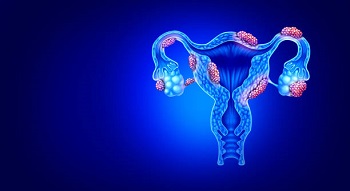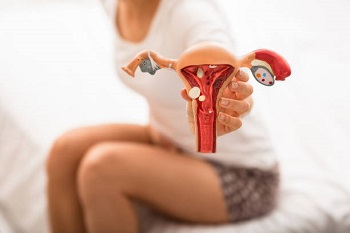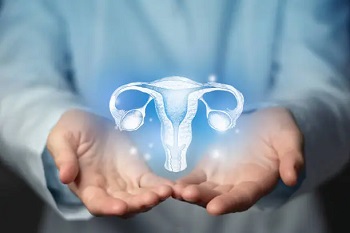
Endometriosis is a painful condition in which tissue from the uterus
attaches itself to other organs. The uterine tissue may appear in the fallopian
tubes or the ovaries, or it may implant itself on the outer walls of the uterus
itself. In rare cases, the tissue travels outside the pelvic region and appears
in organs like the bladder, the lungs, and other areas.
Endometrial tissue masses, also known as endometrial growths, can cause pain and discomfort. These growths behave similarly to the uterus during the menstrual cycle, filling up with blood and shedding it monthly.
However, unlike normal menstrual blood, the blood from these growths has no way to leave the body and accumulates in the pelvic cavity, often forming cysts. With repeated menstrual cycles, the cysts can grow large enough to bind organs together, leading to further complications.
Additionally, ruptured cysts can cause severe pain. It is estimated that two out of three women have endometrial growths on their ovaries.
While endometriosis is not a simple condition to treat, natural therapies
often lead to significant improvement. The complementary treatments
described here focus on regulating hormones and balancing the immune
system and also suggest ways to provide gentle relief of pain and other
symptoms.
Symptoms of Endometriosis

- Pain in the abdomen and the lower back, associated with menses
- Pain with sexual intercourse
- Prolonged or excessive menstrual bleeding
- Digestive problems
- Nausea and vomiting
- Anemia
- Infertility
- Pain with urination and bowel movements
Causes of Endometriosis Include the following;
- Retrograde menstruation
- Endometrial cells that travel through the bloodstream or the
lymphatic system - Heredity
- Hormonal imbalance (relatively high estrogen and low progesterone)
due to poor liver function, diet, xenoestrogens, or ovulatory
dysfunction - Imbalanced immune system
- Flora imbalance (dysbiosis)
Treatment
Diet
- Base your diet on whole grains, beans, and vegetables.
- Choose organic foods whenever possible to avoid the negative effects of pesticides, herbicides, and hormone-laden meats.
- Avoid eating gluten.
- Eat fiber-rich foods to support the good bacteria involved in estrogen metabolism.
- Include fruits and vegetables like apples, cherries, broccoli, and cauliflower in your diet. They contain a substance called indole-3-carbinol that helps the liver remove estrogen.
- Regularly eat beets, carrots, artichokes, dandelion greens, onions, and garlic as they promote liver detoxification.
- Consume organic cultured yogurt to boost the levels of beneficial bacteria in your gut.
- Drink a glass of clean water every two to three hours to support detoxification.
- Avoid inflammatory substances like sugar, caffeine, and alcohol to manage pain.
- Avoid foods that disrupt your immune system, such as processed foods, fried food, refined sugar, and alcohol.
- Take a high-potency multivitamin as directed to support hormone metabolism.
- Vitamin C can improve your immune system. Start with a daily dose of 6 grams and reduce if you experience diarrhea.
- Engage in moderate exercise, like taking a daily walk, to naturally relieve pain.
- Use sanitary napkins instead of tampons to avoid retrograde menstruation.
My 5 Best Supplements for Managing Endometriosis
- Vitex: This herbal remedy can regulate hormones and reduce symptoms like menstrual irregularities and breast pain. It may also slow the growth of endometrial adhesions and improve fertility.
- Zinc: Women with endometriosis often have low levels of zinc, which is an important anti-inflammatory nutrient. Zinc can repair intestinal health and reduce pain.
- Berberine: This supplement has anti-inflammatory properties and can improve immune function. It may also address the bacterial aspect of endometriosis by neutralizing bacterial toxins.
- Turmeric: Turmeric can reduce the size and activity of endometriosis lesions. It works by reducing inflammation and blocking estrogen’s effects. It is best taken as a concentrated capsule or tablet.
- Omega-3s (Fish Oil): Fish oil is effective in relieving period pain when taken at least eight days before menstruation begins.
Other helpful supplements include DIM (Diindolylmethane), Magnesium, Vitamin B6, Milk Thistle, NAC (N-ACETYL CYSTEINE), Vitamin D3, Curcumin and Probiotics.
While these supplements have shown potential benefits for managing endometriosis, more research is needed to fully understand their effectiveness. It is important to consult with a healthcare professional before starting any new supplements.
You don’t have to face these challenges alone! If you have endometriosis and are having trouble getting pregnant or dealing with fertility problems, consider finding a healthcare provider who looks at your overall health and can offer personalized treatments.
If you need someone to talk to or support you, let me know! I’m always here to help. There are more resources available for you to explore. Leave a comment, come back for more information, and reach out if you want someone to go on this journey with you. Thank you for reading!






